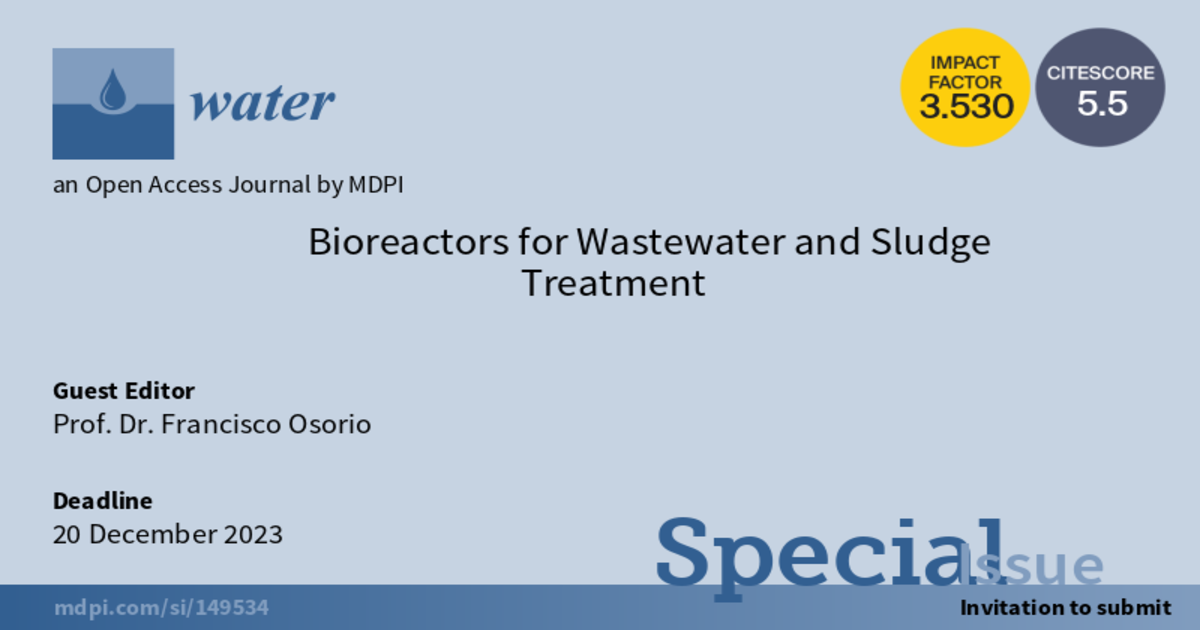Bioreactors for Wastewater and Sludge Treatment
A special issue of Water (ISSN 2073-4441). This special issue belongs to the section "Wastewater Treatment and Reuse".
Deadline for manuscript submissions: closed (20 December 2023) | Viewed by 5416

Special Issue Editor
Interests: water treatment; biofiltration; nitrogen removal; granular systems; salinity; emergent contaminants; molecular biology; WWTP by-products; sewage networks
Special Issues, Collections and Topics in MDPI journals
Special Issue Information
Dear Colleagues,
This Special Issue focuses on the biological treatment of effluents, both of urban and industrial origin. The objectives/applications of the wastewater treatments remain open: organic matter, control of nutrients, emerging contaminants, or other specific contaminants. The different aspects that concern these treatments can be addressed: microbiology, design, operation, investment and exploitation costs, or energy optimization of processes. Any form of presence/retention of the biomass in the reactor will be of interest, with special attention to novel treatment systems: suspended culture, biofilm, hybrids, membranes, or granular.
This Special Issue will also pay attention to the by-products generated in the process, basically sludge and biogas. Aerobic or anaerobic processes in sludge treatment will be analyzed to obtain an optimal product depending on their final destination. In the case of anaerobic processes, the generation of biogas produced and the possibilities of its reuse will be analyzed. Current policies and regulations push us to manage these by-products with a circular economy approach. In this new paradigm, the application of anaerobic treatments stands out in order to reuse the digestate for agricultural or other purposes, to the detriment of other less hygienized amendments and the use of mineral fertilizers, and on the other hand, the use of biogas for energy purposes, preferably for direct use in the facilities themselves, or for other external uses.
Prof. Dr. Francisco Osorio
Guest Editor
Manuscript Submission Information
Manuscripts should be submitted online at www.mdpi.com by registering and logging in to this website. Once you are registered, click here to go to the submission form. Manuscripts can be submitted until the deadline. All submissions that pass pre-check are peer-reviewed. Accepted papers will be published continuously in the journal (as soon as accepted) and will be listed together on the special issue website. Research articles, review articles as well as short communications are invited. For planned papers, a title and short abstract (about 100 words) can be sent to the Editorial Office for announcement on this website.
Submitted manuscripts should not have been published previously, nor be under consideration for publication elsewhere (except conference proceedings papers). All manuscripts are thoroughly refereed through a single-blind peer-review process. A guide for authors and other relevant information for submission of manuscripts is available on the Instructions for Authors page. Water is an international peer-reviewed open access semimonthly journal published by MDPI.
Please visit the Instructions for Authors page before submitting a manuscript. The Article Processing Charge (APC) for publication in this open access journal is 2600 CHF (Swiss Francs). Submitted papers should be well formatted and use good English. Authors may use MDPI's English editing service prior to publication or during author revisions.
Keywords
- biological reactors
- urban and industrial effluents
- pollution control
- sludge treatment
- sludge disposal
- biogas generation and reuse
- circular economy





